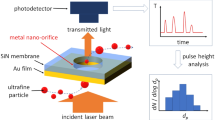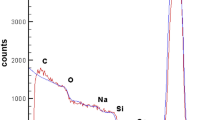Abstract
The potential use of nanoelectromechanical systems (NEMS) created in silicon nanopillars (SiNPLs) is investigated in this work as a new generation of aerosol nanoparticle (NP)-detecting device. The sensor structures are created and simulated using a finite element modeling (FEM) tool of COMSOL Multiphysics 4.3b to study the resonant characteristics and the sensitivity of the SiNPL for femtogram NP mass detection in 3-D structures. The SiNPL arrays use a piezoelectric stack for resonance excitation. To achieve an optimal structure and to investigate the etching effect on the fabricated resonators, SiNPLs with different designs of meshes, sidewall profiles, heights, and diameters are simulated and analyzed. To validate the FEM results, fabricated SiNPLs with a high aspect ratio of approximately 60 are used and characterized in resonant frequency measurements where their results agree well with those simulated by FEM. Furthermore, the deflection of a SiNPL can be enhanced by increasing the applied piezoactuator voltage. By depositing different NPs [i.e., gold (Au), silver (Ag), titanium dioxide (TiO2), silicon dioxide (SiO2), and carbon black NPs] on the SiNPLs, the decrease of the resonant frequency is clearly shown confirming their potential to be used as airborne NP mass sensor with femtogram resolution level. A coupling concept of the SiNPL arrays with piezoresistive cantilever resonator in terms of the mass loading effect is also studied concerning the possibility of obtaining electrical readout signal from the resonant sensors.











Similar content being viewed by others
References
Banerjee A, Mankad T, Dhamodaran S, Ramkumar J, Kulkarni VN (2009) The measurement of attogram mass accumulation on nanostructures during e-beam scanning, using carbon nanopillars in resonant mode. Nanotechnology 20:345501. doi:10.1088/0957-4484/20/34/345501 (7 pp)
Beardslee LA, Josse F, Heinrich SM, Dufour I, Brand O (2012) Geometrical considerations for the design of liquid-phase biochemical sensors using a cantilever’s fundamental in-plane mode. Sens Actuators B 164:7–14. doi:10.1016/j.snb.2012.01.035
Butt HJ, Jaschke M (1995) Calculation of thermal noise in atomic-force microscopy. Nanotechnology 6:1–7
COMSOL (2013) COMSOL Multiphysics Release Notes: Version 4.3b. COMSOL AB, Stockholm, Sweden
Dean J, Gibbs MRJ, Schrefl T (2006) Finite-element analysis on cantilever beams coated with magnetostrictive material. IEEE Trans Magn 42(2):283–288. doi:10.1109/TMAG.2005.861322
Dikin DA, Chen X, Ding W, Wagner G, Ruoff RS (2003) Resonance vibration of amorphous SiO2 nanowires driven by mechanical or electrical field excitation. J Appl Phys 93:226–230
Eom K, Park HS, Yoon DS, Kwon T (2011) Nanomechanical resonators and their applications in biological/chemical detection: nanomechanics principles. Phys Rep 503:115–163. doi:10.1016/j.physrep.2011.03.002
Gil M, Manzaneque T, Hernando-Garcia J, Ababneh A, Seidel H, Sanchez-Rojas JL (2012) Selective modal excitation in coupled piezoelectric microcantilevers. Microsyst Technol 18:917–924. doi:10.1007/s00542-011-1411-y
Hajjam A, Wilson JC, Pourkamali S (2011) Individual air-borne particle mass measurement using high-frequency micromechanical resonators. IEEE Sens J 11(11):2883–2890. doi:10.1109/JSEN.2011.214730301
Hassellöv M, Readman JW, Ranville JF, Tiede K (2008) Nanoparticle analysis and characterization methodologies in environmental risk assessment of engineered nanoparticles. Ecotoxicology 17:344–361. doi:10.1007/s10646-008-0225-x
Hopcroft MA, Nix WD, Kenny TW (2010) What is the Young’s modulus of silicon? J Microelectromech Syst 19:229–238. doi:10.1109/JMEMS.2009.2039697
Kaajakari V, Mattila T, Lipsanen A, Oja A (2005) Nonlinear mechanical effects in silicon longitudinal mode beam resonators. Sens Actuators A 120(1):64–70. doi:10.1016/j.sna.2004.11.010
Kacem N, Arcamone J, Perez-Murano F, Hentz S (2010) Dynamic range enhancement of nonlinear nanomechanical resonant cantilevers for highly sensitive NEMS gas/mass sensor applications. J Micromech Microeng 20:045023. doi:10.1088/0960-1317/20/4/045023 (9 pp)
Ling MP, Chio CP, Chou WC, Chen WY, Hsieh NH, Lin YJ, Liao CM (2011) Assessing the potential exposure risk and control for airborne titanium dioxide and carbon black nanoparticles in the workplace. Environ Sci Pollut Res (International) 18(6):877–889. doi:10.1007/s11356-011-0447-y
Lu J, Ikehara T, Zhang Y, Mihara T, Maeda R (2008) Mechanical quality factor of microcantilevers for mass sensing applications. Proc SPIE 6800:68001Y. doi:10.1117/12.759393
Lu Y, Peng S, Luo D, Lal A (2012) Femtomolar sensitivity DNA photonic crystal nanowire array ultrasonic mass sensor. In: Proceedings of IEEE MEMS 2012, Paris, France, pp. 88–91. doi: 10.1109/MEMSYS.2012.6170100
Luo X, Morrin A, Killard AJ, Smyth MR (2006) Application of nanoparticles in electrochemical sensors and biosensors. Electroanalysis 18(4):319–326. doi:10.1002/elan.200503415
Messina M, Njuguna J, Dariol V, Pace C, Angelett G (2013) Design and simulation of a novel biomechanic piezoresistive sensor with silicon nanowires. IEEE/ASME Trans Mechatron 18(3):1201–1210. doi:10.1109/TMECH.2012.2200258
Pomorska A, Shchukin D, Hammond R, Cooper MA, Grundmeier G, Johannsmann D (2010) Positive frequency shifts observed upon adsorbing micron-sized solid objects to a quartz crystal microbalance from the liquid phase. Anal Chem 82:2237–2242. doi:10.1021/ac902012e
Ramakrishnan N, Nemade HB, Palathinkal RP (2012) Resonant frequency characteristics of a SAW device attached to resonating micropillars. Sensors 12:3789–3797. doi:10.3390/s120403789
Sandberg R, Molhave K, Boisen A, Svendsen W (2005) Effect of gold coating on the Q-factor of a resonant cantilever. J Micromech Microeng 15:2249–2253. doi:10.1088/0960-1317/15/12/006
Schmid S, Kurek M, Adolphsen JQ, Boisen A (2013) Real-time single airborne nanoparticle detection with nanomechanical resonant filter-fiber. Sci Rep 3:1288. doi:10.1038/srep01288 (5 pp)
Seo JH, Brand O (2008) High Q-factor in-plane-mode resonant microsensor platform for gaseous/liquid environment. J Microelectromech Syst 17(2):483–493. doi:10.1109/JMEMS.2008.916328
Sökmen Ü, Stranz A, Fündling S, Merzsch S, Neumann R, Wehmann H–H, Peiner E, Waag A (2010) Shallow and deep dry etching of silicon using ICP cryogenic reactive ion etching process. Microsyst Technol 16:863–870. doi:10.1007/s00542-010-1035-7
Stranz A, Waag A, Peiner E (2011a) Thermal characterization of vertical silicon nanowires. J Mater Res 26(15):1958–1962. doi:10.1557/jmr.2011.60
Stranz A, Sökmen Ü, Kähler J, Waag A, Peiner E (2011b) Measurements of thermoelectric properties of silicon pillars. Sens Actuators A: Phys 171:48–53. doi:10.1016/j.sna.2011.01.022
Tao Y, Li X, Xu T, Yu H, Xu P, Xiong B, Wei C (2011) Resonant cantilever sensors operated in a high-Q in-plane mode for real-time bio/chemical detection in liquids. Sens Actuators B: Chem 157:606–614. doi:10.1016/j.snb.2011.05.030
Wasisto HS, Merzsch S, Waag A, Uhde E, Salthammer T, Peiner E (2013a) Airborne engineered nanoparticle mass sensor based on a silicon resonant cantilever. Sens Actuators B: Chem 180:77–89. doi:10.1016/j.snb.2012.04.003
Wasisto HS, Merzsch S, Stranz A, Waag A, Uhde E, Salthammer T, Peiner E (2013b) Silicon resonant nanopillar sensors for airborne titanium dioxide engineered nanoparticle mass detection. Sens Actuators B: Chem 189:146–156. doi:10.1016/j.snb.2013.02.053
Wasisto HS, Merzsch S, Waag A, Uhde E, Salthammer T, Peiner E (2013c) Portable cantilever-based airborne nanoparticle detector. Sens Actuators B: Chem 187:118–127. doi:10.1016/j.snb.2012.09.074
Wasisto HS, Merzsch S, Waag A, Uhde E, Salthammer T, Peiner E (2013d) Evaluation of photoresist-based nanoparticle removal method for recycling silicon cantilever mass sensors. Sens Actuators A: Phys 202:90–99. doi:10.1016/j.sna.2012.12.016
Wasisto HS, Merzsch S, Stranz A, Waag A, Uhde E, Salthammer T, Peiner E (2013e) Silicon nanowire resonators: aerosol nanoparticle mass sensing in the workplace. IEEE Nanatechnol Mag 7:18–23. doi:10.1109/MNANO.2013.2260462
Wasisto HS, Merzsch S, Stranz A, Waag A, Uhde E, Salthammer T, Peiner E (2013f) Femtogram aerosol nanoparticle mass sensing utilising vertical silicon nanowire resonators. IET Micro & Nano Letters 8(10):554–558. doi:10.1049/mnl.2013.0208
Zhou J, Lao CS, Gao P, Mai W, Hughes WL, Deng SZ, Xu NS, Wang ZL (2006) Nanowire as pico-gram balance at workplace atmosphere. Solid State Commun 139:222–226. doi:10.1016/j.ssc.2006.06.004
Acknowledgments
The authors would like to thank Juliane Arens, Doris Rümmler, and Karl-Heinz Lachmund for their valuable technical assistances. This work is performed in the collaborative project “NanoExpo” funded by the German Federal Ministry of Education and Research (BMBF) within the cluster “NanoCare” under no. 03X0098A.
Author information
Authors and Affiliations
Corresponding author
Rights and permissions
About this article
Cite this article
Wasisto, H.S., Huang, K., Merzsch, S. et al. Finite element modeling and experimental proof of NEMS-based silicon pillar resonators for nanoparticle mass sensing applications. Microsyst Technol 20, 571–584 (2014). https://doi.org/10.1007/s00542-013-1992-8
Received:
Accepted:
Published:
Issue Date:
DOI: https://doi.org/10.1007/s00542-013-1992-8




